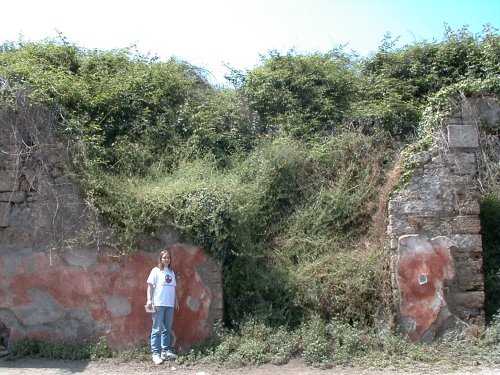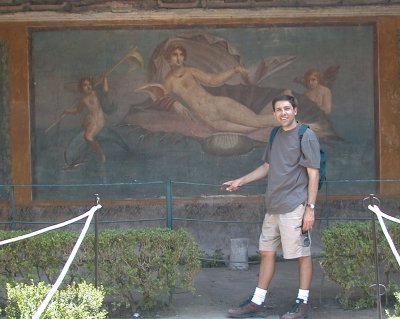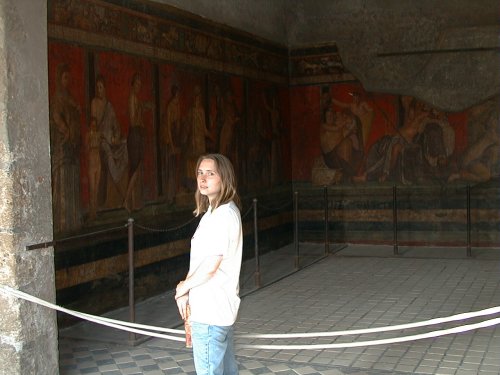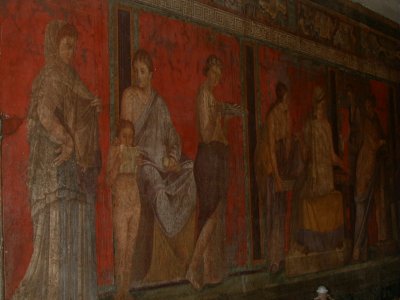
On August 24, 79 A.D., Mount Vesuivius decided to blow and bury
Pompeii under 20 feet of volcanic ash. It wasn't until 1748 that
the first excavations began, and they are still going on today.
While walking around Pompeii, you don't really realize what it
means when you hear that over a million tons of rock have been
removed from Pompeii. That's a lot of stuff, and there's still
about half of the city still under the ash. According to Naomi,
they are leaving the unexcavated parts alone until they develop
better techniques for excavating, and because they want to spend
more time fixing up what they have excavated. It really strikes
home the incredible amount of work excavating Pompeii is when you
see a picture like this one, where you can see what unexcavated
Pompeii looks like.

This is the Arena at Pompeii, near one of the entraces. It's a
huge area that is amazingly well preserved, like most of Pompeii.
It's in much better shape than the Coloseum in Rome, which was
gutted for its marble in order to make statues and monuments.
They have concerts in this Arena as well.

All the roofs in Pompeii were destroyed by the eruption, and this
is what the walls look like. Walking around Pompeii, you can get
such a great feeling for how people lived 2000 years ago. You can
see where the bakery is, where the bath is, where the brothels
are, where people bought drinks at, how they moved around, and so
on. It makes you realize that life was possible before computers
(although web pages about life being possible before computers
weren't possible before computers).

This is a typical fresco in Pompeii. They are all very well
preserved, and you can tell who the rich people were because
their houses were covered with frescos.

This is Naomi at the House of the Little Fountain. Apparently,
the owner of this house saw the fountain at the House of the
Large Fountain and wanted one, but couldn't quite afford the same
thing, so he scaled back a little and this is what you end up
with. The sides of the fountain are lined with shells, and the
water comes out of a spigot in the middle of the fountain.

These are some well preserved bodies of the original inhabitants
of Pompeii. The knew how to eat in ancient Pompeii.

This is in the men's bath house in Pompeii, in the steam room.
The ceiling had grooves in it to take the water that condensed on
it over to the side walls. This was to keep the cold water from
dripping on your head and ruining your bathing experience. The
men's bathroom is much more elaborate than the women's because
the politicians would decorate the bath room and then leave an
inscription somewhere to let the bathers know who had paid for
their bath. This fountain, for instance, has an inscription
around the rim naming the person who donated it and even includes
the exact price he paid for it.

The famous House of the Dancing Faun. Can you guess which one is
the real faun? Surprise, they're both fakes, with the real faun
in a museum in Naples. This is the Dancing Faun that Tam Pham was
trying to get me to steal for his backyard (Is that a faun in
your pants?). I can just see it now on Ebay. Like New! 2000 Year
Old Faun! A faun, by the way, is a man-like creature with a tail.
I always wondered what the hell a faun was.

This is the Villa dei Mistieri. It's a house that's a little bit
outside of the main cluster of buildings, just down the hill, and
it has the best preserved frescos in Pompeii. This is a secret
back room that contains frescos depicting the rites a person
would go through to be in the cult of Dionysus. The color red in
frescos is very rare, as it has to come all the way from China,
so you know this family was loaded. Also, if you expose that
color to sunlight, it turns black. The frescos are incredibly
beautiful and so well preserved. It was really cool seeing this
house. There were frescos like this all over the house. In this
room, it's neat because the characters on the wall are looking
across the room at each other, or the guy in the corner is
checking out what the guy on the wall next to him is doing.

This is a close-up of a fresco at the Villa dei Mistieri. The
small boy reading is Dionysus, nude of course, he was a hotty.

The Villa dei Mistieri had a beautful garden around it. Here's
Jeff among the roses.










